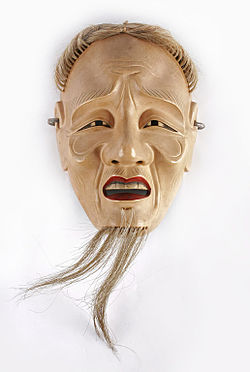Noh



Noh or No (Japanese:能 Nō) is a major form of classical Japanese musical drama. It started in the 14th century and continues today. Noh is made up of mai (dances), hayashi (music) and utai (words usually in songs). The performers use masks and dance slowly. Zeami and his father Kan'ami brought Noh to its present-day form during the Muromachi period.[1]
Types of Noh drama
Theater pieces of Noh are classified into 5 groups.
- Divine; the hero or heroine is divine like a god, heavenly people, and so on. The hero or heroine makes a benediction at the end of the drama.
- Shura-mono (Warrior); the hero (rarely heroine) is a warrior, usually already dead.
- Kazura-mono (Women); the heroine and often her love romance is the focus.
- Zatsu-no (Miscellaneous); Noh which cannot be placed in the other four groups.
- Oni-noh (Oni; demons) ; Non-humans, like oni, tengu (fairy, lion), are the heroes of this type. Mainly it is played at the end of the program.
Noh players
All Noh players are men. They have been taught their skills by their fathers. When a woman or girl appears in the drama, a male actor plays her role with a woman mask.
There are three types of Noh players: shite, waki and kyogen. Shite plays the hero or the heroine. He talks sings and dances. Waki (meaning "Side") and plays the sidekick of Shite. The Waki usually plays the role of a traveler role. He introduces us to the world in the drama. Kyogen appears in the middle of the drama if it has two parts, and plays the role of the local citizen. He talks to Waki and makes him notice something new or realize what has happened.
Music on Noh
Hayashi means musical instrumentals. Two kinds of drum (Tuzumi, Taiko) and a flute (Fue) are used in the theater.
References
- ↑
Noh Media
In the Noh Theatre, 1891 by Ogata Gekkō
Kanze Sakon (1895–1939), head (sōke) of Kanze school
"Noh Theater". japan-guide.com. japan-guide.com. 22 Feb 2016. Retrieved 1 June 2016.






